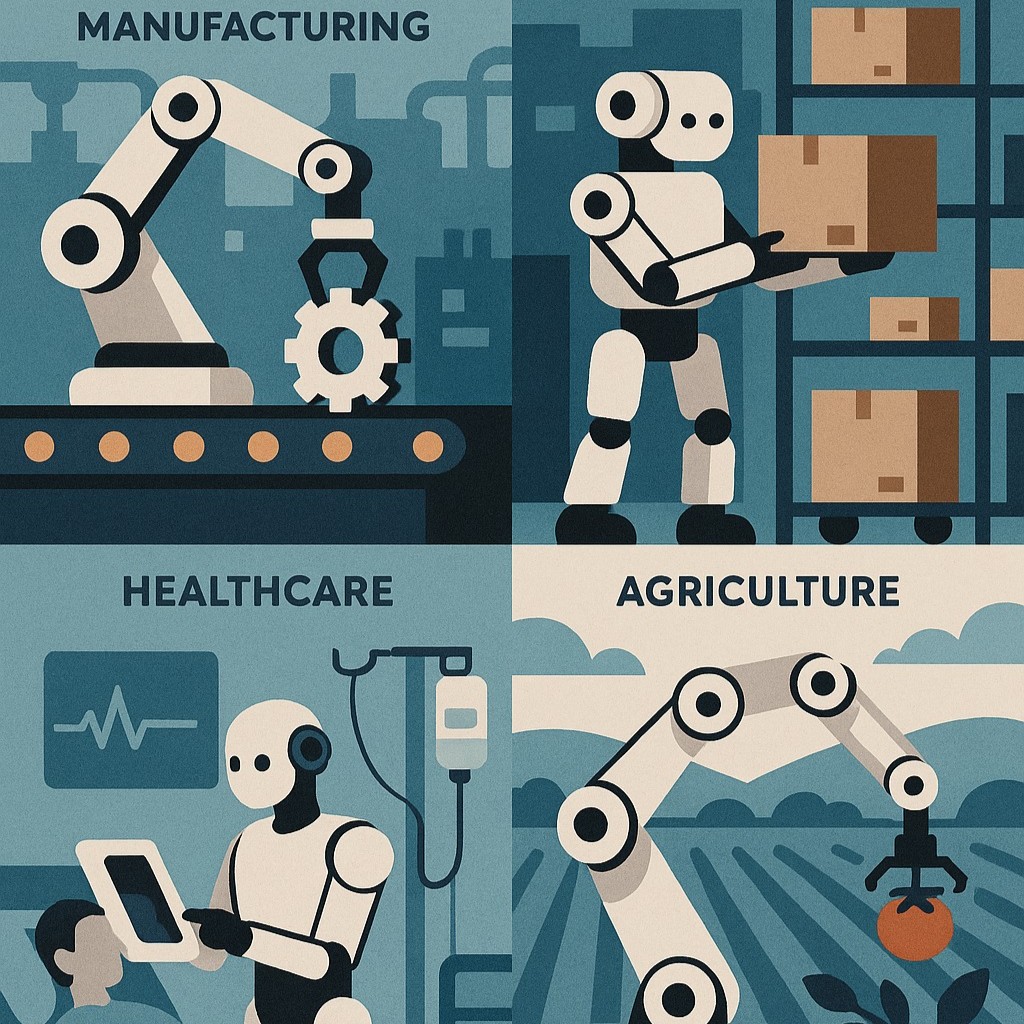
Robotic automation is revolutionizing industries by improving efficiency, precision, and productivity. From manufacturing to healthcare, robots are being integrated into workflows to perform repetitive tasks, enhance quality control, and reduce operational costs.
According to a StartUs Insights report, the robotic automation process (RPA) market is expected to increase at a compound annual growth rate of 24.8%, from $9.91 billion in 2025 to $24 billion in 2029. Over 685k people work for robotic process automation, and in the past year, more than 63K new hires have joined the team.
According to a report by The Business Resource Company, the market for information technology robotic automation is expected to increase at a compound annual growth rate of 18.6%, from $7.66 billion in 2024 to $9.09 billion in 2025.

Current Trends in Robotic Automation
Artificial Intelligence (AI) and Machine Learning Integration
AI-powered robots are capable of making decisions, learning from data, and improving their functions over time. This trend is prominent in manufacturing, logistics, and even service industries where robots analyze patterns to optimize performance.
Collaborative Robots (Cobots)
Unlike traditional industrial robots, cobots work alongside humans to assist in various tasks. They are designed with advanced sensors and AI capabilities to ensure safe human interaction.
Autonomous Mobile Robots (AMRs)
AMRs are being deployed in warehouses, hospitals, and retail spaces for material handling, delivery, and cleaning. These robots use sensors and AI to navigate and operate independently.
Robotic Process Automation (RPA)
Beyond physical robots, RPA is automating digital processes. Software bots handle repetitive administrative tasks such as data entry, invoicing, and customer support, boosting efficiency in business operations.
Healthcare Robotics
Medical robots assist in surgeries, rehabilitation, and patient care. With the rise of telemedicine and robotic-assisted procedures, healthcare is witnessing a new era of precision and accessibility.
Technologies Powering Robotic Automation
AI and Machine Learning
Enhances robot decision-making, vision processing, and adaptability.
Internet of Things (IoT)
Allows robots to connect and communicate with systems, improving real-time monitoring and control.
5G Connectivity
Enables fast and reliable communication between robots and systems, improving response times and efficiency.
Computer Vision
Empowers robots to recognize objects, interpret environments, and make accurate decisions.
Cloud Robotics
Provides centralized data processing and sharing capabilities, reducing the need for extensive onboard computing power.
Benefits of Robotic Automation
Increased Productivity
Robots operate 24/7 without fatigue, boosting efficiency and output.
Enhanced Precision and Quality
Automation reduces human errors, ensuring consistent and high-quality results.
Improved Workplace Safety
Robots handle hazardous tasks, minimizing workplace injuries and ensuring employee safety.
Cost Savings in the Long Run
Despite high initial costs, automation leads to reduced labor expenses and increased efficiency over time.
Scalability and Flexibility
Businesses can scale operations easily with robots, adapting to changing demands quickly.
Risks of Robotic Automation
Job Displacement: The Need for Human Reinvention
As robotic automation becomes more prevalent, especially in industries reliant on repetitive and manual labor, there’s a growing concern over job displacement. Tasks that once required human effort are now executed with precision by machines. While this increases efficiency, it also risks rendering some traditional roles obsolete.
However, this shift doesn’t necessarily mean job loss, it means job transformation. The future workforce will need to reskill and upskill to remain relevant, taking on more strategic, creative, and supervisory roles that complement automation rather than compete with it.
High Initial Costs: A Steep Climb for Long-Term Gains
Investing in robotic automation isn’t cheap. Businesses must bear the heavy upfront costs of purchasing hardware, installing sophisticated software, and ensuring ongoing maintenance. These expenses can be a barrier, especially for small and mid-sized enterprises.
However, it’s important to view this not just as a cost, but as a long-term investment. Once implemented, robots can significantly reduce operational costs, improve accuracy, and boost productivity, offering high returns in the long run.
Cybersecurity Threats: Safeguarding the Digital Workforce
As robots become more interconnected via the Internet of Things (IoT), they also become more exposed to cybersecurity risks. Hackers can exploit vulnerabilities in robotic systems to steal sensitive data, disrupt operations, or even take control of physical processes.
This not only poses a risk to company data but also endangers human safety in certain environments like manufacturing or healthcare.
To combat this, businesses must invest in robust cybersecurity frameworks, ensuring that every robot in the network is shielded from potential threats with updated software, strong encryption, and continuous monitoring.
Technical Challenges: When Machines Misfire
While robotic automation promises unmatched efficiency, it’s not without its technical hurdles. System malfunctions, sensor inaccuracies, and integration issues can bring operations to a sudden halt.
A single sensor failure could disrupt an entire assembly line, while poor system integration can lead to communication breakdowns between robots and legacy systems. These technical hiccups not only cause downtime but also inflate maintenance costs and delay production schedules.
To overcome this, companies must adopt rigorous testing protocols, prioritize predictive maintenance, and ensure seamless system compatibility, because in automation, even the smallest glitch can have massive ripple effects.
Embracing Robotic Automation: Paving the Way for a Smarter Future
Robotic automation is transforming industries by improving efficiency, reducing human effort, and driving innovation. While there are challenges associated with its adoption, the benefits far outweigh the risks. Companies investing in robotic automation today are preparing for a future where intelligent machines work seamlessly alongside humans to drive progress and growth.
In this evolving landscape, automation isn’t about replacing people; it’s about empowering them to focus on strategic, high value tasks while machines handle the repetitive. As technology continues to advance, robotic automation will be central to sustainable growth, continuous innovation, and global competitiveness.
Source
- https://www.startus-insights.com/innovators-guide/robotic-process-automation-market-report/
- https://www.thebusinessresearchcompany.com/report/information-technology-it-robotic-automation-global-market-report
- https://www.uipath.com/rpa/robotic-process-automation#:~:text=Robotic%20process%20automation%20(RPA)%20is,with%20digital%20systems%20and%20software
- https://www.ibm.com/think/topics/rpa


